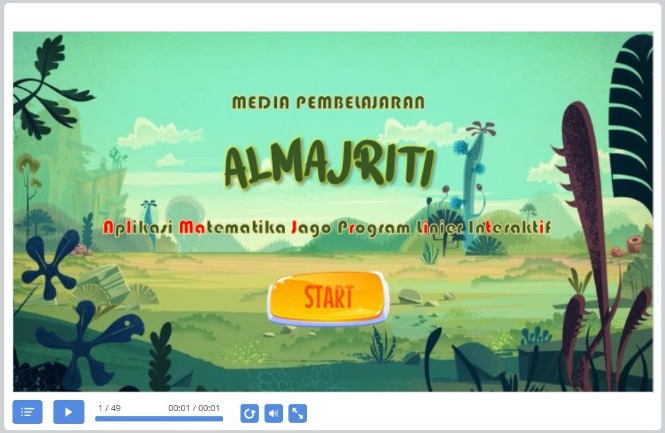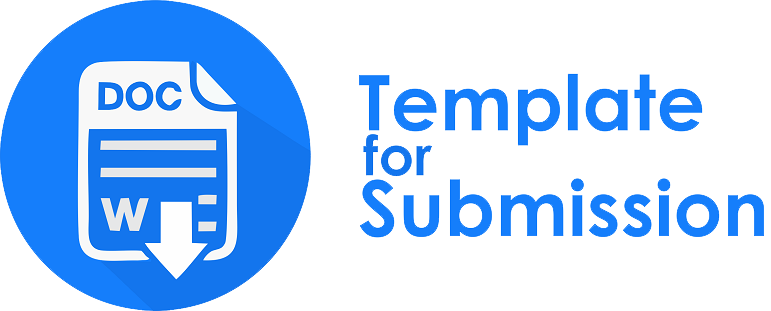DEVELOPMENT OF ALMAJRITI (APLIKASI MATEMATIKA JAGO PROGRAM LINIER INTERAKTIF) FOR CLASS XI STUDENTS OF SENIOR HIGH SCHOOL
Abstract
This research aims to develop a valid ALMAJRITI (Aplikasi Matematika Jago Program Linier Interaktif) learning media and to determine student responses. Student responses were obtained from questionnaires and tests (pre-test and post-test). The study conducted is in the form of R&D with ADDIE steps. Media, learning, material, IT (Information Technology), language, and practitioners experts validate the media. The validation results obtained from each validator sequentially are 100% (very valid), 85% (very valid), 84.62% (very valid), 70% (valid), 87.5% (very valid), 96 ,87% (very valid). The media is very valid if it gets 75% or more. Overall, the media obtained a very valid assessment result of 87.33%, so the media was feasible to use. Meanwhile, the test instrument was validated by a material expert. The media was tested in class XI IPA 3 MAN 1 Blitar. The use of media shows a positive student response. More than 65% of students gave a positive response based on the questionnaire results. In addition, the average pre-test was 17.07, the post-test was 77.5, and the percentage increase in student learning outcomes was 405%. Thus, there is an increase in student learning outcomes before and after using ALMAJRITI. This increase shows a positive response from students to the ALMAJRITI. Therefore, it can be concluded that the ALMAJRITI media is valid and feasible to be used as a learning resource for class XI students
Downloads
References
Apsari, P. N., & Rizki, S. (2018). Media pembelajaran matematika berbasis Android pada materi program linear. Aksioma, 7(1), 161–170.
Aripin, I. (2018). Konsep dan aplikasi mobile learning dalam pembelajaran biologi. Jurnal Bio Educatio, 3(1), 1–9.
Asyhar, R. (2011). Kreatif mengembangkan media pembelajaran. Jakarta: Gaung Persada Press.
Branch, R. M. (2009). Instructional design: The ADDIE approach (Vol. 722). Springer Science & Business Media.
Chasanah, F. M. (2021). Pengembangan video pembelajaran untuk meningkatkan minat belajar matematika siswa sekolah menengah pertama pada materi aritmetika. Universitas Islam Negeri Maulana Malik Ibrahim Malang.
Dahlstrom, E. (2012). ECAR Study of Undergraduate Students and Information Technology. Louisville: EDUCAUSE Center for Applied Research.
Darmawan, D. (2013). Teknologi pembelajaran. Bandung: PT Remaja Rosdakarya.
Fauzy, A., & Nurfauziah, P. (2021). Kesulitan pembelajaran daring matematika pada masa pandemi covid-19 di SMP Muslimin Cililin. Jurnal Cendekia : Jurnal Pendidikan Matematika, 5(1), 551–561. https://doi.org/10.31004/cendekia.v5i1.514
Gikas, J., & Grant, M. M. (2013). Mobile computing devices in higher education: Student perspectives on learning with cellphones, smartphones & social media. The Internet and Higher Education, 19, 18–26. https://doi.org/10.1016/j.iheduc.2013.06.002
Kominfo. (2017). Survey penggunaan TIK 2017. Jakarta. Retrieved from www.kominfo.go.id
Leung, A. (2017). Exploring techno-pedagogic task design in the mathematics classroom. In Digital Technologies in Designing Mathematics Education Tasks (pp. 3–16). Springer International Publishing. https://doi.org/10.1007/978-3-319-43423-0
Luh, N., & Ekayani, P. (2021). Pentingnya penggunaan media pembelajaran untuk meningkatkan prestasi belajar siswa. Jurnal Fakultas Ilmu Pendidikan Universitas Pendidikan Ganesha Singaraja, 2(1), 1–11.
Melfawani, W., Roza, Y., & Maimunah, M. (2022). Analisis kesulitan siswa dalam pembelajaran matematika menggunakan Learning Management System selama pandemi. Jurnal Cendekia : Jurnal Pendidikan Matematika, 6(1), 837–847. https://doi.org/10.31004/cendekia.v6i1.802
Nisa’, A. Z., Marhayati, & Masamah, U. (2022). Strategi self-regulated learning untuk menurunkan tingkat prokrastinasi akademik siswa pada tugas program linier. Jurnal Pengembangan Pembelajaran Matematika, 3(1).
Nisa’, A. Z., & Rofiki, I. (2022). Kegiatan pembelajaran berbasis video sebagai strategi penguatan moderasi beragama santri di kota Blitar. Journal of Dedicators Community, 6(1). https://doi.org/https://doi.org/10.34001/jdc.v6i1.2295
Nisa’, A. Z., Susanti, E., Rofiki, I., & Chandra, F. (2021). Hambatan bernalar siswa SMP dalam menyelesaikan masalah kontekstual. In J. Juhari (Ed.), SI MaNIs (Seminar Nasional Integrasi Matematika dan Nilai-Nilai Islami) (Vol. 4, pp. 110–116). Malang: Mathematics Department, Universitas Islam Negeri Maulana Malik Ibrahim Malang. Retrieved from http://conferences.uin-malang.ac.id/index.php/SIMANIS/article/view/1500
Nisa, A. Z., & Marhayati. (2022). Pengembangan aplikasi M-Learning materi program linier sebagai sumber belajar siswa SMA kelas XI. Universitas Islam Negeri Maulana Malik Ibrahim.
Nisiyatussani, N., Ayuningtyas, V., Fathurrohman, M., & Anriani, N. (2018). GeoGebra applets design and development for junior high school students to learn quadrilateral mathematics concepts. Journal on Mathematics Education, 9(1), 27–40.
Rahayu, S. S., Rinaldi, A., & Gunawan, W. (2021). Aplikasi program linear : Media pembelajaran berbasis Android menggunakan MIT App Inventor. 2682(1), 107–120.
Sari, I. W., & Sumuslistiana, S. (2018). Aplikasi mobile learning berbasis android sebagai media pembelajaran pada materi program linear kelas XI di SMA Widya Dharma Surabaya. MUST: Journal of Mathematics Education, Science and Technology, 3(2), 175–193.
Sattarov, A. ., & Khaitova, N. . (2019). Mobile learning as new forms and methods of increasing the effectiveness of education. European Journal of Research and Reflection in Educational Sciences, 7(12), 1169–1175. Retrieved from http://www.idpublications.org/wp-content/uploads/2019/12/Full-Paper-MOBILE-LEARNING-AS-NEW-FORMS-AND-METHODS-OF-INCREASING-THE-EFFECTIVENESS.pdf
Segal, R., Stupel, M., & Oxman, V. (2016). Dynamic investigation of loci with surprising outcomes and their mathematical explanations. International Journal of Mathematical Education in Science and Technology, 47(3), 443–462. https://doi.org/10.1080/0020739X.2015.1075613
Setiawan, T. H., & Aden. (2020). Efektifitas penerapan blended learning dalam upaya meningkatkan kemampuan akademik mahasiswa melalui jejaring schoology di masa pandemi covid-19. Jurnal Pembelajaran Matematika Inovatif (JPMI), 3(5), 493–506. https://doi.org/10.22460/jpmi.v3i5.493-506
Sriyanti, A., Wahyuni, S., Latuconsina, N. K., & Amin, R. (2022). Pengembangan E-Modul berbantuan software Sigil dengan pendekatan kontekstual pada materi program linear peserta didik kelas XI. Jurnal Cendekia : Jurnal Pendidikan Matematika, 6(1), 300–313. https://doi.org/10.31004/cendekia.v6i1.1070
States, L., & Odom, J. (2016). Surviving on mars with geogebra. North American GeoGebra Journal, 5(2), 48–55.
Sungkono. (2008). Pemilihan dan penggunaan media dalam proses pembelajaran. Majalah Ilmiah Pembelajaran, 71–80

Copyright (c) 2022 Asfira Zakiatun Nisa', Marhayati Marhayati, Faizal Chandra

This work is licensed under a Creative Commons Attribution-NonCommercial-ShareAlike 4.0 International License.
License and Copyright Agreement
By submitting a manuscript to Jurnal Pendidikan Matematika (JUPITEK), the author(s) certify and agree to the following terms:
- Originality and Authority: The submitting author is authorized by all co-authors to enter into this agreement. The manuscript describes original work that has not been published previously in a peer-reviewed journal, nor is it under consideration for publication elsewhere.
- Approval: Its publication has been approved by all author(s) and by the responsible authorities of the institutions where the work was carried out.
- Rights: The authors secure the right to reproduce any material that has already been published or copyrighted elsewhere.
- Licensing and Copyright: Authors retain the copyright to their work.
- License Grant: The authors grant Jurnal Pendidikan Matematika (JUPITEK) the right of first publication, with the work simultaneously licensed under the Creative Commons Attribution-NonCommercial-ShareAlike 4.0 International (CC BY-NC-SA 4.0).
- Self-Archiving: Authors are permitted and encouraged to deposit the published version of their article in institutional repositories, on their personal websites, and other academic platforms, with proper acknowledgment of its initial publication in Jurnal Pendidikan Matematika (JUPITEK).





.png)


